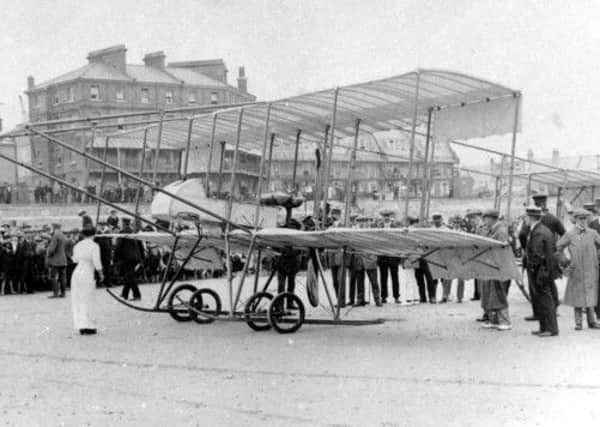NOSTALGIA: Bognor’s magnificent men and their flying machines


A remarkable collection of documents and photographs depicting those early days of flying in Bognor has come to the County Record Office in Chichester. It relates to the brothers, Cecil and Eric Pashley, pioneer aviators who before the first world war were instrumental in the development of Shoreham as one of the first half dozen airfields in the country.
The brothers were still in their teens when they taught themselves to fly and were among the youngest of the first generation of British pilots. They were contemporaries of such legendary figures as Tommy Sopwith. Another of the pioneers was Albert Edward Geere, who persuaded them to make their first flight to Bognor. Flying was then a hazardous experience and their heroics and eccentricities made them celebrity figures. Geere’s claim to fame was once flying his aeroplane with one hand while with the other restraining a hysterical lady passenger who tried to throw herself overboard.
Advertisement
Hide AdAdvertisement
Hide AdThe Pashley brothers’ first visit to Bognor was on Monday, May 26, 1913. A large crowd had assembled on the pier and along the Esplanade opposite the Beach Hotel. “It seemed as though all Bognor was there,” reported the Bognor Observer. At 7pm the flying machine was spotted approaching from the Felpham direction. There were hearty cheers as it circled and made a ‘glorious’ descent to the sandy beach, just east of the pier. Police sergeant Henry Thomas and his constables, plus members of the Coastguard, kept the spectators at bay while the brothers alighted.
The proprietor of the Beach Hotel, Arthur Benbow Taylor, had organised the event and provided hospitality for the welcoming party, including Thomas Start, chairman of the Urban District Council. He had his reward for the following day, at 9am, he became the first Bognorian to take to the skies in a flying machine, his flight to Shoreham taking 25 minutes.
The machine was a two-seater Henry Farman bi-plane. The pilot and the passenger sat out in the open, the pilot in the front seat. It was known as a ‘pusher’ as the engine, a 50hp Gnome, and the propeller were located behind the pilot, an unusual concept by today’s standards. Indeed, the design made it prone to stalling, but despite this apparently life-threatening limitation, the Farman became the most popular biplane before the first world war.
Eric Pashley returned to Bognor on Saturday, June 14, 1913, landing in the same spot, where, according to the Observer, ‘thousands flocked to see the aviator’. This time a number of locals were taken up for short ‘joy’ flights, including Mrs Elizabeth Taylor, the wife of the hotelier. It wasn’t a cheap experience. Two guineas per head, in fact, which worked out at about £1 per mile.
Advertisement
Hide AdAdvertisement
Hide AdNor was it entirely without alarm. On the penultimate flight the aircraft descended faster than usual, destined it seemed to hit the pier until the pilot executed a sharp turn, scattering the crowds on the beach as it came in to land. Such hair-raising incidents were by no means uncommon in those early days of flying.
These were the first visits of a land aeroplane to Bognor. They were captured in a series of photographs, some locally published as picture postcards, and fortunately several are now preserved in the Pashley archives.
But a year earlier, on Saturday, August 3, 1912, the town had attracted another pioneer, Claude Grahame-White, who brought his sea plane to Bognor as part of his ‘Wake-Up England’ campaign to promote public interest in aviation. The Observer correspondent reported that he flew his machine ‘to the first groyne of Mr Gray’s bathing huts’ to a great cheer from the masses waiting on the seafront.
Arthur Taylor was once more to the fore, leading a flotilla of rowing and motor boats to greet the distinguished visitor, and inviting him back to the Beach Hotel for lunch. Meanwhile, the ‘water plane’, as it was called, remained anchored at sea as enterprising boatmen ferried locals out to sea to get a closer look at the machine. Alas, a ‘tricky wind and choppy sea’ thwarted the planned pleasure flights and disappointed the huge crowds that by now stretched from the pier to Aldwick.
Advertisement
Hide AdAdvertisement
Hide AdMr Grahame-White, who that same year gave HG Wells his first flight, eventually took off for Cowes, but not before photographs had been taken, one of which, from the Pashley collection, is reproduced here.
Eric Pashley, the first man to pilot a land aeroplane to Bognor, was killed while serving with the Royal Flying Corps in the first world war. But his older brother, Cecil, who accompanied him on the historic visit to Bognor in 1913, continued flying at Shoreham until just before his death in 1969, completing more than 50 years as a flying instructor. Their collection is a wonderful addition to the aviation archives at the County Record Office.
n If you are interested in local or family history come along to the Record Office in Orchard Street, Chichester, PO19 1DD.
For a special slide and film presentation on Rural Life in West Sussex do come to the latest in our series of talks at the Novium, Chichester’s new museum, on Friday, March 22 at 2pm.
For details ring 01243 753602 or email: [email protected]